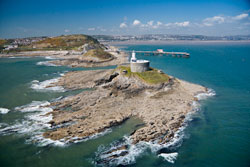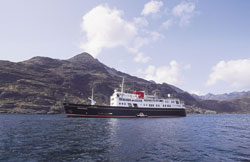Whether you choose to take a scenic coastal path, or travel by train or boat, there are many ways to explore the extensive and unrivalled coastline of this great island nation.

When it comes to exploring Britain, where better to start than the coast? As an island nation and with over 11,000 miles of coastline offering a mix of history, wild beauty and picturesque villages, there’s plenty to discover, whatever the time of year.
From shingle beaches to rugged cliffs, and sand dunes to rocky shores, Britain’s coastline has played an important role in shaping our island’s history. It’s a story of maritime excellence, of trade routes and invasions, of defence, exploration and ship building. Today much is protected – whether as Areas of Outstanding Natural Beauty, National Parks, Geoparks or UNESCO World Heritage Sites – thus safeguarding the coast for years to come. The work of the National Trust also plays an important role in protecting some of the most beautiful stretches, and its Neptune Coastal Campaign which, with public support, helps save beautiful coastal locations from development and promotes access for all, is now in its 44th year.
With nowhere in Britain more than 80 miles from the sea, our coast is ripe for exploring and much of it accessible by train, car, bike or boat. Lighthouses and castles punctuate the land, Victorian piers reach into the waters, and remains of centuries of coastal defences tell the stories of threat from overseas. Castles still stand guard: climb the polygonal towers of Caernarfon for views over the Seiont River, descend into Dover Castle’s secret wartime tunnels, or stroll across the dunes at night to the ghostly ruins of Dunstanburgh in Northumberland, bats flying overhead.
There’s an abundance of wildlife to look out for: spot bottlenose dolphins in Cardigan Bay in Wales or at Moray Firth in Scotland; basking sharks and grey seals off the south and eastern coasts, and puffins in Northumberland, and, of course, there are countless seabirds too.
Waves worthy of champion surfers can be found in the West Country; long broad beaches in north Norfolk; a sense of wilderness in Northumberland; breathtaking beauty in Scotland; miles of unspoilt coastline in Wales, and in Dorset a fascinating trip back through time, thanks to the geographical splendour of the Jurassic Coast.
 |
| Hebridean Princess |
The Jurassic Coast, stretching from Dorset to East Devon, is undeniably one of our most beautiful, and popular.
Amounting to a staggering 95 miles, this Area of Outstanding Natural Beauty covers some 44 per cent of Dorset and is awe-inspiring and yet familiar in equal measure. Golden sandy beaches and seaside towns rub shoulders with such wonders as the natural harbour of Lulworth, the great pebble bank of Chesil Beach, and the highly dramatic, natural limestone arch that’s Durdle Door.
As a whole, it’s a veritable journey through some 200 million years of the Earth’s natural history, its geology revealing the Jurassic – dinosaur footprints are regularly uncovered in Purbeck – Triassic and Cretaceous periods. This may well be one of the Natural Wonders of the World, alongside the Great Barrier Reef and the Grand Canyon, but don’t just head for the obvious, search out the less popular bays and coves too as they’re equally rewarding, and remember that the ideal time to find fossils is during the winter months, after the seas have washed away the soft muds and clays.
Footpaths of varying lengths are found in abundance throughout the United Kingdom, including 15 National Trails. From rugged cliff-top walks to easy lowland routes along broad beaches, the coast is just as well covered as the more inland countryside. From Poole Harbour in Dorset you can join Britain’s longest National Trail – the South West Coast Path, which stretches for a staggering 630 miles to Minehead in Somerset on the edge of Exmoor National Park. Whether you want a short stroll or fancy a more lengthy challenge, this offers coastal walking for everyone, taking in bustling ports, picturesque fishing harbours and mile after mile of the stunning scenery and protected landscapes that have long inspired the artistic community.
Britain’s maritime heritage can be explored at one of the maritime museums or historic dockyards around the country. Portsmouth Historic Dockyard on the south east coast boasts a number of fascinating museums and exhibitions, as well as HMS Warrior and HMS Victory – Lord Nelson’s flagship at the Battle of Trafalgar – to explore. Plus the hull of Henry VIII’s warship the Mary Rose is being re-homed in a museum due to open in 2011.
Also well worth a visit are some of Britain’s coastal National Parks such as Wales’ Pembrokeshire Coast National Park. Its 186-mile path, running from Amroth in the south to St Dogmaels in the north, affords almost constant views of the sea from its landscape of rugged cliffs and sandy beaches, wooded estuaries and wild hills. It even takes in Milford Haven Estuary, which is one of the finest natural harbours in the world.
Or there’s the Fife Coastal Path in Scotland, a series of fantastic walks stretching from North Queensferry in the south to the Tay Bridge in the north. Home to historic castles, hidden caves, quaint fishing villages and 25 beaches, Fife’s coastline offers peace and tranquility and also the buzz of activity with watersports and golf being popular pastimes.
The fabulous coast of Antrim is another highlight – you’ll see sheltered harbours and slipways, fishermen’s cottages and impressive rock formations, but the main attraction is undoubtedly the array of basalt columns (the result of an ancient volcanic eruption) that make up the Giants Causeway – a World Heritage Site and National Nature Reserve. Owned and managed by the National Trust, visitors are free to wander over these largely hexagonal stones – it’s estimated there are around 40,000 in total – that can be reached either by road or on foot, and have stood for millions of years as a natural defence against the harsh Atlantic storms.
Your explorations don’t all have to be done on foot however, why not rediscover the romance of train travel? Brunel’s stunning south Devon coast railway offers one of the most scenic journeys in the world and quite possibly the most photographed stretch of railway in the UK. From the cathedral city of Exeter, the route hurries along the River Exe past the Powderham Castle estate, sweeps along the sea wall at Dawlish (sometimes taking a full washing from the waves), ducks in and out of tunnels punctuated by brief and tantalising views of cliff, beach and sea, before emerging onto the Teign Estuary, passing Shaldon and Ringmore villages on its way up to Newton Abbot. In summer, the real romantics can make the journey by steam train. And a little farther southwest, you can join the heritage railway that runs for seven miles alongside the Torbay coast from Paignton to Dartmouth. Torbay itself was named a Geopark by UNESCO in 2007, one of just 57 such areas around the world and the world’s only urban Geopark (for details see page 69).
An alternative and increasingly popular way of discovering Britain’s coastline is onboard a round-Britain cruise.
A round-Britain cruise offers the perfect opportunity to take in much of the coastline and the various ports of call take you to the major sights and cities of Britain and Ireland. Small, large, luxury – there’s a ship to suit all tastes, and a variety of departure points across the country too, but it’s perhaps in and around the many islands of Scotland that the small ships really come into their own. The Caledonian MacBrayne ferry takes passengers to 24 destinations on Scotland’s West Coast but for a more round-trip experience look to Hebridean Princess. Carrying just 49 guests, this luxury ship can easily slip into the small inlets and remote ports waiting to be explored on the rugged coastline of the Highlands and islands of Scotland. Or there’s Majestic Line who carry a maximum of 12 guests each in two beautifully-converted traditional wooden vessels taking in the sheltered lochs and islands of South Argyll and the Inner Hebrides.
And for an altogether different cruising experience turn to THV Patricia, the working ship of Trinity House, the General Lighthouse Authority for England, Wales and the Channel Islands. Patricia carries just 12 passengers as she completes her work maintaining navigational buoys and dealing with emergencies at sea. The fact that her itinerary can change at a moments notice, makes this a truly unique holiday.
Whether you climb up a lighthouse, stroll down a pier, enjoy a moment of solitude on a wild sweep of beach or cruise to a remote island, you’ll discover ours is a coast of contrasts, a special place where history and nature reign supreme.






 © 2024
© 2024